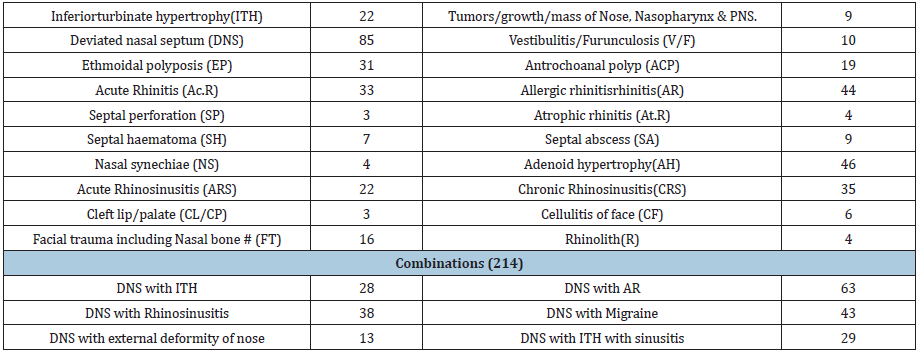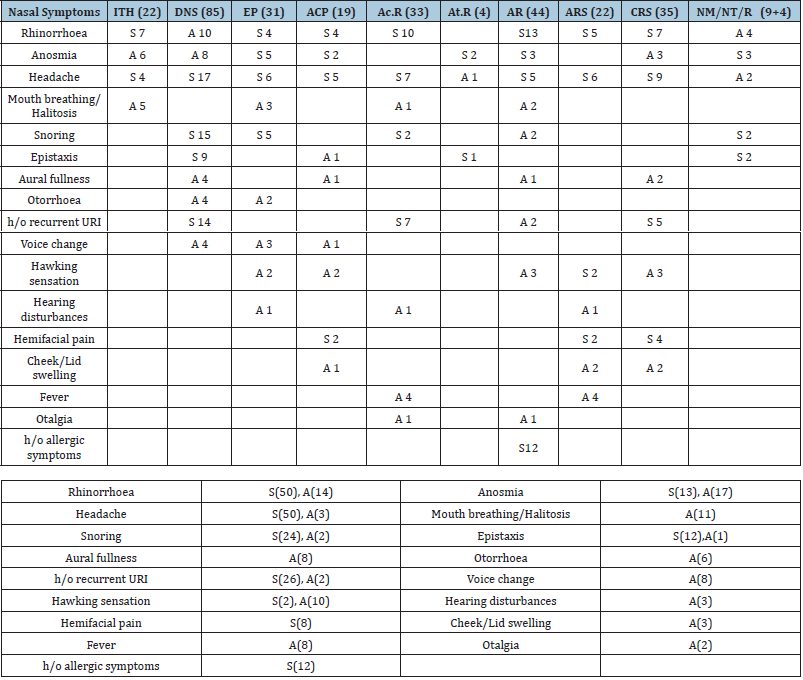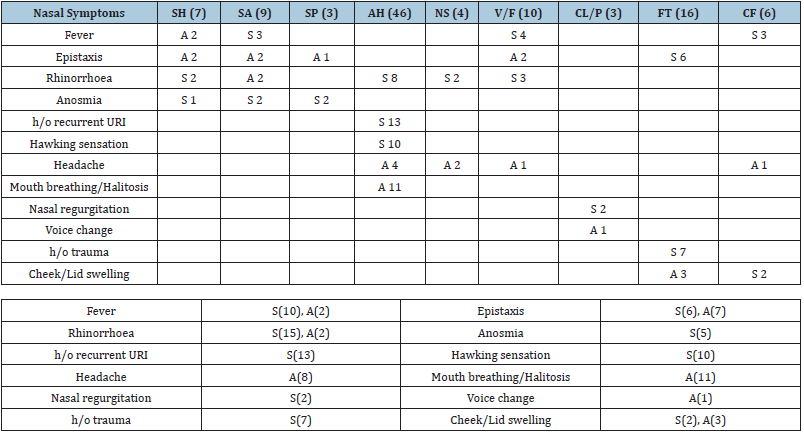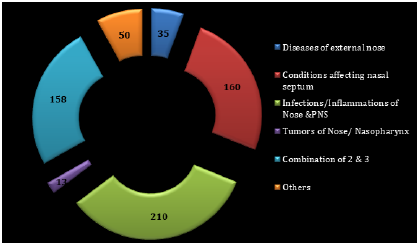- Submissions

Full Text
Experiments in Rhinology & Otolaryngology
Revisit on How Nasal Blockage has an Effect on Eminence of Life: Facts & Specifics
Sphoorthi Basavannaiah*
Department of ENT, Subbaiah Institute of Medical Sciences, Shimoga, Karnataka, India
*Corresponding author: Sphoorthi Basavannaiah, Assistant Professor, Department of ENT, Subbaiah Institute of Medical Sciences, Shimoga, Karnataka , India
Submission: May 15, 2020;Published: May 26, 2020

ISSN 2637-7780 Volume3 Issue2
Abstract
Introduction: Nasal breathing distributes roughly 70% airflow to lungs, but airway obstruction can limit airflow through nose. This limitation of nasal airway obstruction through nose has both mucosal as well as mechanical causes that can significantly compromise the quality of life.
Aims & Objectives: To find out the commonest cause for nasal obstruction, level of obstruction as well as affection of involvement in Nose & PNS. This topic is of interest as nasal obstruction, though has a common existence & prevalence but certain crucial factors that compromise quality of life is still untouched upon in literature.
Methodology: All 626 patients who presented with various causes of nose block were clinically evaluated and suitable management was disposed.
Results: Both Mucosal & Mechanical groups have their own role in involvement for the basis of nasal obstruction.
Conclusions: DNS & Developmental origin go hand in hand and is by far occupying nearly 50% of causes for nasal obstruction, which indirectly suggests that septal correction is mandatory after facial development when symptomatic & when basics in life are at stake.
Keywords: Nasal blockage; Nasal obstruction; Nasal airway; Airflow; Deviated nasal septum (DNS); Paranasal sinuses(PNS)
Introduction
Nasal breathing distributes roughly 70% airflow to lungs, but airway obstruction can limit airflow through nose. While it is a known fact that ear, nose & throat are interlinked with each other in the form of “triangular immersion”. Hence, any cause of nasal block can in a way limit the functioning capacity of the other two systems [1,2]. This limitation of nasal airway obstruction (NAO) through nose has mucosal &mechanical causes that range from PNS to DNS that can significantly compromise the excellence & eminence of life leading to un pleasant alarms [3].
Aims & Objectives
a) To find out the various causes for nasal obstruction.
b) To look for nasal block based on level of obstruction/any abnormalities of nose &
PNS.
c) To group nasal block causes as per affection of areas in Nose & PNS.
d) To categorize nasal obstruction according to the aetiology.
e) To classify nasal obstruction as per the symptomatology of presentation.
f) To evaluate disease with relevance to symptom based on gender & age predisposition
of occurrence in terms of ratio.
g) To group the conditions based on their chronicity & laterality.
Objective
It is to bring into light the 3 basic & vital features that hinder the value of healthy living such as breathe, smell & sleep as not much about it is mentioned in the literature.
Materials and Methods
A. Study design: Descriptive study
B. Place of study: Tertiary Care Hospital, Subbaiah Institute of Medical Sciences, Shimoga.
C. Study period: 1 year (from August 2018 to July 2019).
D. Selection criteria: A random sample of 626 patients (pts) who consulted the ENT outpatient department with nasal obstruction as one of the clinical presentation were assessed &evaluated clinically, diagnosis was made. Following which, required management algorithm was adapted in all the patients both conservatively as well as surgically.
1) Inclusion criteria
a) Age group from 5-70 years were considered for the study.
b) All cases of only nasal pathology were considered for the study.
2) Exclusion criteria
a) Age group of < 5years and >70 years were excluded from the study.
E. Procedure of the study: Over a period of 1 year, a random sample of 626pts who consulted ENT OPD with nasal obstruction as one of their main symptom were clinically evaluated after taking a detailed & thorough history. Following which a probable diagnosis was made. The relevant investigations wherever necessary were done to arrive at a diagnosis.
Management was given based on the diagnosis which was both conservative as well as surgical. They were then followed up for about 6 months. Patients have shown good response to treatment on follow up with symptomatic relief. Informed written consent was taken during the study period. Ethical clearance has been taken from Institutional Ethics Committee before the start of the study.
Results
The observations drawn from the study are depicted both in diagrammatic as well as tabular representation below: (Table 1-4; Figures 1-5)
Table 1:Based on causes for nasal obstruction-----------412+214= 626.

Table 2:Of 626pts with nasal pathology, table below shows symptoms accompanying nasal obstruction as Secondary (SS) & Associated (AS) which is depicted in the tabular presentation below (Table 2, 3 & 4).

Table 3:Symptoms accompanying nasal obstruction in various nose pathology.

Table 4:Symptoms accompanying nasal obstruction in various nose pathology.

Figure 1:Bubble representation showing the total population in terms of gender & age included in the study. The percentage distribution among them is 95 children (15%) & 531 adults (85%) while 338 males (54%) & 288 females (46%).

Figure 2:Exploded 3D Pie depicted based on level of obstruction/ abnormalities of Nose & PNS.

Figure 3: Exploded doughnut diagram showing affection of areas in Nose & PNS with causes of nasal obstruction.

Figure 4:Clustered column representation for causes of nasal obstruction based on their aetiology.

Figure 5: 3D Pyramid illustration showing region involvement for symptomatology of nasal obstruction.

Discussion
Nasal congestion is the most common symptom for both mucosal
& mechanical cause in nose & PNS region. Congestion, due to physical
obstruction of nasal passages as a result of structural variations
&/or modulation of sensory perception. Mucosal inflammation
has precise and solid factors that contribute to nasal congestion
[4,5]. Biologically active agents & cell types (eg, histamine, TNF-α,
IL’s, cell adhesion molecules) contribute to inflammation, that
manifest as raised nasal secretions, venous engorgement &tissue
oedema. This can possibly cause impaired airflow & feeling of nasal
congestion [6,7]. Altered sensory perception & subjective sense of
congestion are due to inflammation-induced changes in sensory
afferents which innervate nose through expression of peptides &
receptors [8,9].
Nasal congestion has many causes that range from a mild
irritation to lethal condition. The various sources for nasal block
can cause headache to halitosis due to inflammatory to iatrogenic
pathology& developmental to dangerous concern [10,11]. Various
origins range from simple coryza to complex concha bullosa,
narrow nasal valve to wide cleft palate as well as upper airway
resistance syndrome to empty nose syndrome all of which can lead
to nasal obstruction. As it known that face has a rich blood supply,
specifically nose which has the most constricted and confined
vessels and (danger area of face). Hence, any neglected conditions
can lead to severity in the form of cavernous sinus thrombosis etc,
jeopardising life [12,13].
Most people are referred to as “obligate nasal breathers”.
During first few months of life, nasal congestion in an infant can
interfere with breastfeeding causing respiratory distress while in
older children & adolescents it can just be bothersome with certain
difficulties. Nasal congestion can interfere with hearing and speech
[14,15]. Significant congestion mainly in adults and sometimes in
children even may interfere with sleep cause snoring with mouth
breathing that can be associated with sleep apnoea or upper airway
resistance syndrome [16-18]. While in children, nasal congestion
from adenoid hypertrophy has caused chronic sleep apnoea with
insufficient levels of oxygen causing hypoxia as well as right-sided
heart failure. This problem can be resolved with knocking out both
tonsils & adenoids. However, this problem often relapses later in
life due to craniofacial alterations from chronic nasal congestion
[19,20].
Hence, any cause of nasal obstruction must evaluate
thoroughly. After which proper treatment modality has to be
administered & followed either conservative line as in Antibiotics,
Nasal decongestants either topical & oral, Antihistamines with +/-
Analgesics. Surgical line of treatment [21,22] as per requirement is
Septoplasty +/- Submucous resection, Partial inferior turbinectomy
& Functional Endoscopic sinus surgery (FESS). The same protocol
was followed in our case too. After a Diagnostic nasal endoscopy
& CT PNS, appropriate treatment measures were adapted [23-
25]. Total 626pts were considered for the study. Pts presented
with various nasal pathology comprising of 26 conditions (with
20 single causes & rest 6 with combined causes). They presented
with nasal obstruction as their Primary Symptom (PS) over a study
period of 1 year and were followed over for 6 months now. Nasal
obstruction has been categorically dissected into various groups
which are individually elaborated in the matter mentioned below.
Out of 26 causes for nasal obstruction that were presented at
the OPD, 412pts (66%) belonged to single causes while 214pts
(34%) belonged to combined causes for nasal obstruction. The
top 5 causes for nasal obstruction are DNS-85pts, Rhinitis-81pts,
DNS with AR-63pts, Rhinosinusitis-57pts & Nasal polyposis- 50pts.
While it is mostly combined causes with DNS which form the bulk
of pts, that totals up to (214+ 85=299pts) (48%). This data in the
study here shows that nearly 50% of causes fall under Mechanical
group which is superior to Mucosal cause for nasal obstruction that
is DNS.
As per age & sex distribution in this study, 95pts were children
(C) & 531pts were adults (A) and their ratio of C:A is nearly 1:6.
While 338pts were males (M) & 288pts were females (F) and their
ratio of M:F is nearly 1:2. This data in the study here tells us that
there is wide gap difference between Children & Adults while that
is not so in Males & Females.
In this study with reference to the chroni city of conditions,
126pts (20%) had Acute (A) causes for nasal obstruction while
rest 500pts (80%) had Chronic (C) causes. Hence the ratio of A:C
is 1:4. This data in the study refers to the fact that acute cases
are far less in occurrence compared to chronic. Hence, mostly
conservative management is by far proven sufficient and also pts
have become more aware& alert to get medical help at the earliest.
But considering the laterality of involvement in terms of causes for
nasal obstruction, 145pts (23%) had Unilateral (U/L) involvement
while rest 481pts (77%) had Bilateral (B/L) involvement. B/L
involvement specifies the need for immediate surgical management
and also postulates the importance to have a good quality of life in
terms of breathe, smell & sleep as a part of healthy lifestyle. Hence,
the ratio of U/L:B/L is nearly 1:4. There is no particular preference
or any relevance to the side of involvement either Right or Left side
of the nose for nasal obstruction in this study.
As per the level of obstruction with reference to nasal causes,
they were categorised into 4 groups: Mucosal-138pts (22%),
Mechanical- 245pts, Combined Mucosal+Mechanical-138pts (25%)
& Others-85 pts (14%). In this category, Mechanical causes for nasal
obstruction topped the list with 39% involvement most commonly
encountered in this study. As Mucosal causes mainly involves
compromising the Osteomeatal complex (OMC) which is Rhinitis
& Rhinosinusistis while Mechanical causes is purely Anatomical
constraints that include DNS, ITH, Any mass/ growth/polyps etc.
Among areas of affection in nose, the causes were classified into
6 groups: 1. Diseases of External nose-35 pts (6%), 2. Conditions
affecting nasal septum-10pts (26%), 3. Infections & Inflammations
of nose & PNS- 210 pts, 4. Tumors of nose/nasopharynx/PNS-13pts
(2%), 5. Combined 2+3- 158pts (25%) & 6. Others- 50pts (8%).
Infections & Inflammations of Nose & PNS topped the list with
33% input most commonly come across in this study. Diseases of
external nose includes- Cleft lip/palate, Furunculosis/Vestibulitis,
Facial cellulitis, Facial trauma with # Nasal bone & external nose
deformity, Rhinoscleroma, Rhinophyma. No cases of the latter two
have been come across so far in the OPD. Conditions affecting nasal
septum includes- DNS, Septal abscess, Septal haematoma, Septal
perforation. Infections/ Inflammations of Nose & PNS- Rhinitis,
Rhinosinusistis, Polyps, ITH, Nasal mass etc & Others- postoperative
nasal synechiae, Adenoid hypertrophy.
According to aetiology behind occurrence of nasal obstruction,
they have been assembled into 8 groups: Developmental-143pts
(23%), Traumatic-106pts (17%), Hereditary-69pts (11%),
Habitual (nose picking & recurrent clearing of nose due to regular
URI)-10pts (2%), Inflammatory-227pts, Neoplastic-13 pts (2%),
Iatrogenic-12pts (2%), Others-46pts (7%). The main root cause
which topped the list for nasal obstruction with terms to aetiology
is Inflammatory with 36% contribution that came across in the
study.
Along with nasal obstruction as the Primary symptom during
presentation during OPD visit, there were around 21 other
symptoms as Secondary & Associated for all nasal pathology. Based
on which, both region of involvement as well as symptoms as
such were gathered down. Among all the symptoms, Rhinorrhoea
topped the list of most common accompanying symptom mainly as
Secondary symptom and was seen in 132pts (21%), while Headache
in 107pts (17%), h/o recurrent URI along with Mouth breathing/
Halitosis & Snoring were seen in 59pts (9%) which ranked second
and third in the list of symptom presentation. While, distribution of
accompanying symptoms with nasal block in all pts were somewhat
evenly dispersed with no particular inclination as such.
While coming over to the region involvement in terms with
clinical presentation, but obvious Nose is most common system
among the other two to involve in 481pts (77%). While 39pts (6%)
in Ear & 106pts (17%) in Throat & Other region of involvement.
Discussion
This study is one of a kind with numerous, exclusive conclusions are drawn:
a) Mechanical group> Mucosal group in terms of cause
for nasal obstruction, which is DNS; seen in nearly 50% (i.e
299pts).
b) Based on Age distribution, the ratio for (Children: Adult)
is nearly 1:6.
c) As per Gender predilection, the ratio for (Males: Females)
is nearly 1:2.
d) According to Chronicity of conditions, the ratio for (Acute:
Chronic) is 1:4.
e) While the Laterality of involvement of the nasal conditions
showed a ratio of (U/L: B/L is nearly 1:4).
f) 39% (i.e 245 pts) had Mechanical causes for nasal
obstruction based on level of obstruction.
g) Based on areas of affection in nose, Infections &
Inflammations of Nose & PNS listed with 33% (i.e210pts).
h) As per aetiology of occurrence of all the conditions causing
nasal obstruction, inflammatory diseases fall with 36% (i.e227
pts).
i) Rhinorrhoea was seen as the most common accompanying
Secondary symptom in 21% (i.e 132 pts).
j) According to region involvement in terms with clinical
presentation, but obviously Nose is most common system in
481 pts (77%).
The purpose of this study is to also bring into light which was somewhere out of focus & dusted amidst other priorities are3 simple & must essentials that are needed to lead a healthy living which is being hindered. Those 3 basic amenities needed are Air to respire, Aroma to make food tastier& palatable and calm &peaceful Nap. All of them are crucial for a strong body and mind. Hence, nasal obstruction should be simply not neglected but must be sorted at the earliest for a well-being.
References
- Kara M, Erdoğan H, Güçlü O (2016) Evaluation of sleep quality in patients with nasal septal deviation via the Pittsburgh Sleep Quality Index. J Craniofac Surg 27(7): 1738-1740.
- Pawankar R (2003) Nasal polyposis: an update: editorial review. Curr Opin Allergy ClinImmunol 3(1): 1-6.
- Teichgraeber JF, Gruber RP, Tanna N (2016) Surgical management of nasal airway obstruction. Clin Plast Surg 43(1): 41-46.
- Fraser L, Kelly G (2009) An evidence-based approach to the management of the adult with nasal obstruction. Clin Otolaryngol 34(2): 151-155.
- Mygind N, Dahl R, Bachert C (2000) Nasal polyposis, eosinophil dominated inflammation, and allergy. Thorax 55(Suppl 2): S79-S83.
- Chandra RK, Patadia MO, Raviv J (2009) Diagnosis of nasal airway obstruction. Otolaryngol Clin N Am 42(2): 207-225.
- Bachert C, Gevaert P, Holtappels G (2002) Mediators in nasal polyposis. Curr Allergy Asthma Rep 2(6): 481-487.
- Udaka T, Suzuki H, Fujimura T (2007) Chronic nasal obstruction causes daytime sleepiness and decreased quality of life even in the absence of snoring. Am J Rhinol 21(5): 564-569.
- Corey JP, Houser SM, Ng BA (2000) Nasal congestion: a review of its etiology, evaluation, and treatment. Ear Nose Throat J 79(9): 690-698.
- Staevska MT, Baraniuk JN (2007) Differential diagnosis of persistent non allergic rhinitis and rhinosinusitis syndromes. Clin Allergy Immunol 19: 35-53.
- Moore GF, Freeman TJ, Ogren FP (1985) Extended follow-up of total inferior turbinate resection for relief of chronic nasal obstruction. Laryngoscope. 95(9 1): 1095-1099.
- Farmer SE, Eccles R (2006) Chronic inferior turbinate enlargement and the implications for surgical intervention. Rhinology 44(4): 234-238.
- Emanuel IA, Shah SB (2000) Chronic rhinosinusitis: allergy and sinus computed tomography relationships. Otolaryngol Head Neck Surg 123(6): 687-691.
- Ciprandi G, Cirillo I, Vizzaccaro A (2004) Nasal obstruction in patients with seasonal allergic rhinitis: relationships between allergic inflammation and nasal airflow. Int Arch Allergy Immunol 134(1): 34-40.
- Wright ED, Pearl AJ, Manoukian JJ (1998) Laterally hypertrophic adenoids as a contributing factor in otitis media. Int J Pediatr Otorhinolaryngol 45(3): 207-214.
- Fokkens W, Lund V, Bachert C (2005) EAACI position paper on rhinosinusitis and nasal polyps executive summary. Allergy 60(5): 583-601.
- Berger G, Kattan A, Bernheim J (2000) Acute sinusitis: a histopathological and immunohistochemical study. Laryngoscope 110(12): 2089-2094.
- Cole P, Chaban R, Naito K (1988) The obstructive nasal septum. Effect of simulated deviations on nasal airflow resistance. Arch Otolaryngol Head Neck Surg 114(4): 410-412.
- Meltzer EO, Hamilos DL, Hadley JA (2004) Rhinosinusitis: establishing definitions for clinical research and patient care. Otolaryngol Head Neck Surg 131(6 Suppl): S1-S62.
- Bachert C, Gevaert P, Holtappels G (2000) Nasal polyposis: from cytokines to growth. Am J Rhinol 14(5): 279-290.
- Berrettini S, Carabelli A, Sellari-Franceschini S (1999) Perennial allergic rhinitis and chronic sinusitis: correlation with rhinologic risk factors. Allergy 54(3): 242-248.
- Kaliner MA, Osguthorpe JD, Fireman P (1997) Sinusitis: bench to bedside. Current findings, future directions. Otolaryngol Head Neck Surg 116(6 Pt 2): S1-S20.
- Wang DY, Raza MT, Gordon BR (2004) Control of nasal obstruction in perennial allergic rhinitis. Curr Opin Allergy Clin Immunol 4(3): 165-170.
- Hedman J, Kaprio J, Poussa T (1999) Prevalence of asthma, aspirin intolerance, nasal polyposis and chronic obstructive pulmonary disease in a population-based study. Int J Epidemiol 28(4): 717-722.
- Warwick-Brown NP, Marks NJ (1987) Turbinate surgery: how effective is it? A long-term assessment. ORL J Otorhinolaryngol Relat Spec 49(6): 314-320.
© 2020 Sphoorthi Basavannaiah. This is an open access article distributed under the terms of the Creative Commons Attribution License , which permits unrestricted use, distribution, and build upon your work non-commercially.
 a Creative Commons Attribution 4.0 International License. Based on a work at www.crimsonpublishers.com.
Best viewed in
a Creative Commons Attribution 4.0 International License. Based on a work at www.crimsonpublishers.com.
Best viewed in 







.jpg)






























 Editorial Board Registrations
Editorial Board Registrations Submit your Article
Submit your Article Refer a Friend
Refer a Friend Advertise With Us
Advertise With Us
.jpg)






.jpg)














.bmp)
.jpg)
.png)
.jpg)










.jpg)






.png)

.png)



.png)






